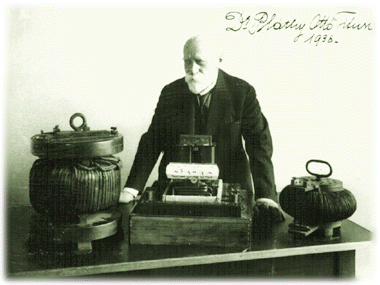|
OTTÓ TITUSZ BLÁTHY (1860 - 1939) |
 |
Born in Tata, Bláthy was educated locally and in Vienna. He received his diploma of mechanical engineering at the Technical University of Vienna in 1882. He began working at the Ganz factory as a mechanical engineer in 1883, and his activities tied him to the factory for the remainder of his life. A remarkably talented man, Bláthy quickly recognized problems, and his intellect was characterized by an exceptionally long memory as well as a command of languages. He was the first to outline the practical application of Ohm's law of magnetism.
His most important invention was the transformer, developed jointly with Zipernowsky and Déri in 1885. On Bláthy's recommendation, the transformers were produced with a closed iron core. Their joint effort resulted in one of the most important electronic inventions of that period. His patents, more than a hundred in number, relate mostly to electric machinery.
From 1887 he experimented with AC (alternating current) generators connected in parallel, an arrangement which was implemented one year later at an Italian power station. It was a worldwide sensational event that he connected a thermal plant with a hydroelectric power station for the first time. In 1889 he designed the kilowatt hour meter named after him. Many similar devices had been known, but only Bláthy's one proved reliable in practice. He even improved upon its accuracy in 1912. The kilowatt hour meters used at present operate on the same principle as his original invention. Bláthy was an honorary member of the Hungarian Academy of Sciences from 1927, held honorary Ph. D. degrees from the Technical Universi-ties of Budapest and Vienna, and many more distinctions were conferred upon him.
Closed-core and shell-core transformer (1885)
The development of the electrical industry was hindered by the fact that the dynamo could only supply electricity trouble-free to short distances; to longer distances a large portion of electric energy got "lost" through overheated cables. The electrical engineers of that period were well aware that cheap electrical transmission could only be achieved by increasing the voltage. However, the experiments with DC (direct current) constantly ended in failure.
Between 1884 and 1885 three engineers at the Ganz factory, Ottó Titusz Bláthy, Miksa Déri and Károly Zipernowsky developed a new current distribution system based on the use of the induction apparatus called transformer. Their joint patent described a transformer with no poles and comprised two versions of it, the "closed-core transformer" and the "shell-core transformer."
In the closed-core transformer the iron core is a closed ring around which the two coils are arranged uniformly. In the shell type transformer, the copper induction cables are passed through the core. The core consists of iron cables or plates.
Based on this invention, it became possible to provide economical and cheap lighting for industry and households.

